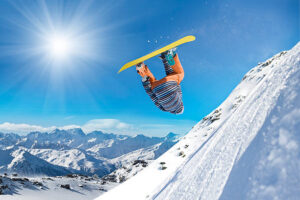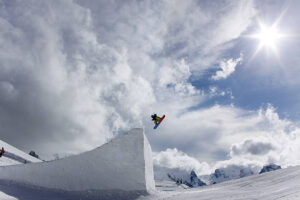Halfpipe Snowboarding Takes the Olympics by Storm: A Look at the Evolution and Future of the Sport
In the Winter Olympics, it’s easy to focus on speed and racing events like alpine skiing and snowboarding, speed skating, and the ominously named skeleton. However, some of the most incredible feats of skill are shown in events that emphasize technique over speed.
Halfpipe snowboarding is an exciting event with big air and jaw-dropping tricks. Snowboarders who compete in halfpipe olympic events need incredible
Read on to learn more about halfpipe snowboarding, where the sport came from, where it’s going, and it’s biggest stars.

What is Halfpipe Snowboarding?
 The name of the halfpipe snowboarding event comes from the manmade terrain feature where it takes place. The halfpipe refers to a large half-tube of snow with curved walls on either side. The entire halfpipe slopes down enough for snowboarders to maintain speed on the way down.
The name of the halfpipe snowboarding event comes from the manmade terrain feature where it takes place. The halfpipe refers to a large half-tube of snow with curved walls on either side. The entire halfpipe slopes down enough for snowboarders to maintain speed on the way down.
Halfpipes originated with natural gulleys and other terrain features at resorts that were groomed until some resorts started building full halfpipes from the ground up.
Snowboarders will start at the top lip of the half pipe in drop-in, ride across, and up to the other lip where they launch high in the air. This is where the competition part comes in.
In the air, a snowboarder will perform tricks like flips, twists, and more. They are judged on the difficulty, height, and execution of their tricks.
After coming down from the air, the snowboarder drops back into the halfpipe and speeds to the other side for another launch. They will cross back and forth several times on the way down the pipe, launching up in the air and doing new tricks each time they come off the lip of the halfpipe.
When Was Halfpipe Snowboarding Introduced?
Halfpipe snowboarding first started in the early eighties when snowboarders started taking jump runs in natural gulley features. Over time as snowboarding grew in popularity, resorts started grooming these natural features and then building entire artificial quarter and halfpipes from the ground up.
Halfpipe made its first appearance in the Olympics in 1998, the first year that the Olympics featured any snowboarding events. Halfpipe snowboarding was an instant hit and has been one of the most popular Winter Olympics sports ever since.
Halfpipe Snowboard Tricks
 Halfpipe snowboarding is different from speed-focused winter sports in that competitors are judged on the tricks they perform rather than their time down the hill.
Halfpipe snowboarding is different from speed-focused winter sports in that competitors are judged on the tricks they perform rather than their time down the hill.
There is a huge variety of tricks that snowboarders can do on the halfpipe, and ambitious snowboarders are working on creating new tricks all the time. Read on to learn more about some of the amazing tricks snowboarders take on during a halfpipe event.
Frontside 1080
The frontside 1080 is where the snowboarder takes off the lip of the halfpipe forward, spins around three full rotations, and then lands back down in the opposite direction.
Backside 900
The backside 900 is a trick where a snowboarder takes off forward and spins around two and a half times with their back to the wall, then lands with the same foot leading as they started with.
Triple Cork
The triple cork is one of the most difficult tricks that’s ever been done on a halfpipe. Shaun White originally started working on the triple cork but decided it was too risky.
The triple cork involves spinning three times end-over-end in the air. It involves a tremendous amount of power and control and is a very dangerous trick. Snowboarders attempting this trick will usually try it toward the end of their run so they have space to build up enough momentum to get high in the air for this trick.
1440
1440 is an awesome trick to watch because it requires a lot of speed, height, and spins. The 1440 requires a snowboarder to spin around four full rotations in the air before coming back down into the halfpipe.
Halfpipe Snowboard Judging
In the Olympic halfpipe snowboarding event, riders get three chances to run the halfpipe and are assigned a score for each run by a panel of judges. The highest score of all the runs is used to determine the winner.
Judges look at a variety of factors when scoring halfpipe runs. Here are the different aspects that are taken into account when judging halfpipe events:
- Amplitude: This term simply means the height snowboarders get from the lip. Launching higher in the air during runs will earn a rider a higher score.
- Execution: One of the most important aspects of scoring is how well snowboarders execute their tricks. If they are crisp, precise, and well-timed, they will get a higher score than if they fumble or are unstable on the landing.
- Difficulty: It’s not just how well riders do their tricks, but how difficult they are that counts. Snowboarders will receive a higher score for attempting more difficult or ambitious jumps, spins, and grabs. Slipping slightly during a very difficult trick can often earn a higher score than a perfectly executed easy trick.
- Variety: Doing the same trick over and over isn’t likely to earn a high score. The best snowboarders mix up their runs with forward and backward spins and flips and by switching up their positioning during tricks.
- Snowboarders are also given higher scores for trying new tricks or combinations that haven’t been done. In this way, the sport continues to evolve as riders continuously try out new tricks.
Shaun White – Most Famous Halfpipe Athlete
 No discussion of halfpipe snowboarding in the Olympics would be complete without mentioning Shaun White. Growing up in Southern California, Shaun White got his start in skateboarding. At a young age, his skateboarding skills quickly drew attention and led him to go professional in skateboarding at just sixteen years old.
No discussion of halfpipe snowboarding in the Olympics would be complete without mentioning Shaun White. Growing up in Southern California, Shaun White got his start in skateboarding. At a young age, his skateboarding skills quickly drew attention and led him to go professional in skateboarding at just sixteen years old.
Shaun started snowboarding in the mountains of Southern California, and his skateboarding skills quickly translated to the slopes.
He competed in the winter Olympics for the first time in 2006. During the 2006 Olympics, he won gold in halfpipe snowboarding. He went on to win the halfpipe gold medal two more times in the 2010 and 2018 Olympics as well while making fourth place in both the 2014 and 2022 Olympics.
Shaun White’s Olympic career has spanned sixteen years. Few athletes have ever competed in five different Olympics, and his skill, personality, and style have helped redefine the sport of Olympic halfpipe and brought it into popularity.

 About the author
About the author